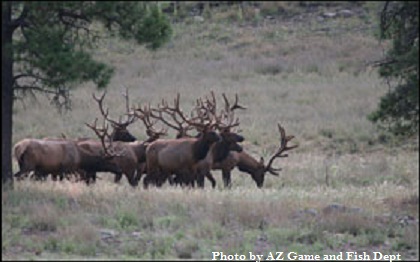In the News: Elk Targeted Over Aspen
Note to website readers: We have included this article that does not talk about Mexican gray wolves because it so obviously should include them. The absence of large carnivores like wolves has contributed to this situation, and the restoration of wolves to these lands is an essential part of the solution. We hope you will help to educate people about this with a letter to the editor responding to this article.
************************************************************************************************************************************
 Hunters are being invited to shoot elk high on the San Francisco Peaks again this coming fall — any age and either gender — to reduce populations of the aspen-eating animals.
Hunters are being invited to shoot elk high on the San Francisco Peaks again this coming fall — any age and either gender — to reduce populations of the aspen-eating animals.
The Arizona Game and Fish Department is opening it up as a “physically challenging” hunt to promote aspen regeneration on the San Francisco Peaks, including Hart Prairie.
It proposes to offer 390 tags for hunting in the mostly wilderness area. There will be four anterless elk hunts and three any-elk hunts.
This is the second year the agency has opened the area for elk hunts with an intention to help young aspen trees survive to adulthood.
“We are offering these permits in coordination with the Coconino National Forest as another habitat management tool for aspen regeneration on the Peaks,” said Carl Lutch, wildlife program manager for the Flagstaff Game and Fish office. “There are other factors affecting aspen trees, but reducing the number of elk that utilize aspen is one piece of the puzzle in helping aspen recover on the Coconino National Forest.”
…
This article appeared in the Arizona Daily Sun.
*****
Please take this opportunity to write a letter to the editor. This article gives a prime example of why keystone predators, like the Mexican gray wolf, are critical for healthy ecosystems.
The letters to the editor page is one of the most widely read, influential parts of the newspaper. One letter from you can reach thousands of people and will also likely be read by the U.S. Fish and Wildlife Service. Tips and talking points for writing your letter are below, but please write in your own words, from your own experience.
Letter Writing Tips & Talking Points
Below are a few suggestions for ensuring your message gets through clearly-your letter will be most effective if you focus on a few key points, so don’t try to use all of these. If you need additional help or want someone to review your letter before you send it, email it to info@mexicanwolves.org.
- Start by thanking the paper for publishing the article. This makes your letter immediately relevant and increases its chances of being published.
- At one time, wolves and other large carnivores helped to keep nature in balance and reduced the impacts of large mammals like elk on vegetation. The Aspen decline and many other issues that we see on our forests can be greatly improved by restoring wolves to their natural role.
- Many people support the recovery of wolves in the Grand Canyon region and this article illustrates why this is so important. Wildlife biologists believe that Mexican wolves will improve the overall health of the Southwest and its rivers and streams — just as the return of gray wolves to Yellowstone has helped restore balance to its lands and waters.
- Even though Mexican gray wolves were reintroduced to their native lands in Arizona and New Mexico almost 15 years ago, the wild population continues to struggle, not because of any lack on the part of the wolves, but because the U.S. Fish and Wildlife Service refuses to make the changes needed for these wolves to succeed.
- One of the changes needed is to change the rule that does not allow the existing small population of Mexican gray wolves in Arizona and New Mexico to expand into other suitable areas, like the Grand Canyon region. This would help our wildlands and increase the wolves’ chances of a successful recovery.
- Studies by multiple scientists show that the Grand Canyon region, which extends from the Mogollon Rim up into southern Utah, has some of the best remaining suitable areas for wolves.
- The majority of Arizona voters support the Mexican wolf reintroduction. Polling showed 69% support in New Mexico and 77% support in Arizona.
- Keep your letter brief, under 250 words.
- Provide your name, address, occupation, and phone number; your full address, occupation, and phone number will not be published, but they are required in order to have your letter published.
For more information, visit the Grand Canyon Wolf Recovery Project at www.gcwolfrecovery.org
Submit your letter to the editor here.
Thank you!
Click here to join our email list for Mexican gray wolf news and action alerts.
Visit us on Facebook.



